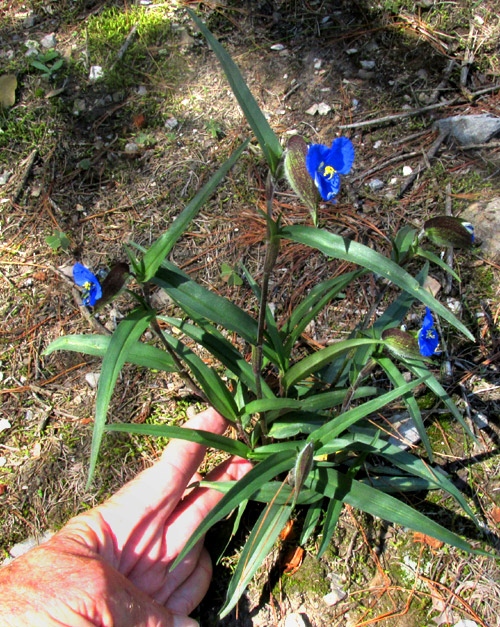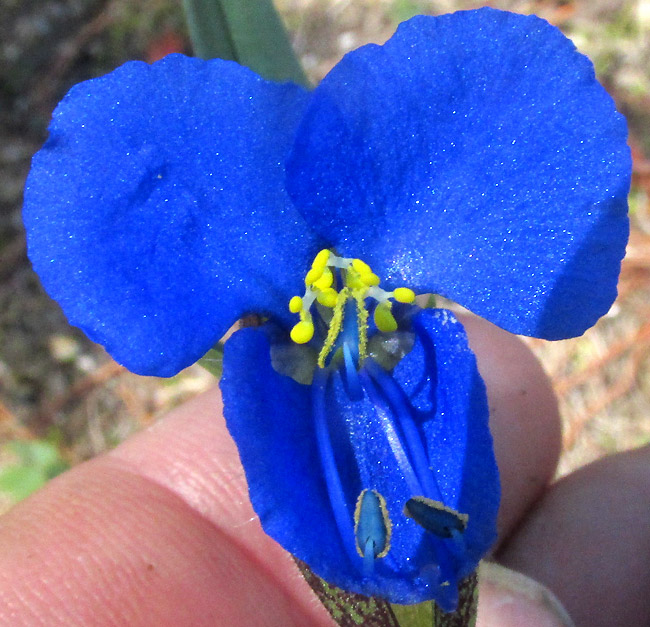Excerpts from Jim Conrad's
Naturalist Newsletter
Entry from field notes dated September 3, 2023, taken in Los Mármoles National Park in the Eastern Sierra Madre mountains, Hidalgo state, MÉXICO; oak-pine forested mountain peak about 3km west of Puerto de Piedra, on road branched off the road between Trancas {on maps designated "Morelos (Trancas)"} and Nicolás Flores; limestone bedrock; elevation ~2,600m (~8,500); N20.816°, W99.214°
COMMELINA TUBEROSA, "COELESTIS GROUP"

On an eroded slope in an oak-pine forest grazed by roving cattle, the above wildflower seemed to be posing in a narrow beam of sunlight. With somewhat succulent, grasslike leaves and large blue blossoms composed of three petals and with something yellow in the center, it had to be a member of the large Dayflower or Spiderwort Family, the Commelinaceae.

The yellow things were three sterile, modified stamens, known as staminodes. Their white filaments branched, with each branch tip mounted by a much modified, yellow anther compartment, the yellowness probably helping pollinators find their nectar. Below the staminodes, three stamens with blue, long filaments curving downward and then upward bore blue anthers at their tips with edges powdered with pollen. The middle stamen curved upward most strongly, its anther partly obscuring our view of the staminodes. A side view of the flower makes clear which genus our plant is:

The semi-heart-shaped green and purple feature in the picture's center is one side of a spathe, which is a modified leaf or sheathing bract enclosing a flower cluster. The spathe's flat sides fold together, protecting flower buds nested between them. When the buds open, the flowers -- usually one at a time, for a day -- emerge and attract pollinators. Above, a single emerged flower is shown from the side. At the corolla's very bottom, notice the slender, blue, curving item which is neither a stamen nor a staminode; it's the stigma-topped style ready to receive pollen from pollinators.
In our part of the world, if you have a member of the Commelina Family with three distinct petals, six stamens of which three are sterile staminodes, and the blossoms are clearly bilaterally symmetrical, you have the genus Commelina, whose species are known as dayflowers. About 170 species of Commelina, mostly tropical, currently are recognized. The 2021 study by José Luis Villaseñor and others entitled "Riqueza y distribución de la flora vascular del estado de Hidalgo, México" lists eleven Commelina species documented for our upland central Mexican state of Hidalgo.

Above it's seen that the lower stems are heavily colored with purple, the plant is several-branched from the base, and very short hairs tend to line up along ridges on the stems. The center of the picture is occupied by the sheath at the bottom of a leaf where the leaf base wraps completely around the stem.
Details of vegetative parts are important for determining which of the eleven species documented for Hidalgo state we have. Several species are quite similar. For example, our plant is very much like the Spreading Dayflower. That species tends to recline more on the ground, and its petals, on the average, display relatively longer petiole-like bases.
Commelina taxonomy is confused and disputed. Using available floras for identification, our plant works out to Commelina coelestis. However, Kew's Plants of the World database and other international authorities currently regard that species name as synonymous with Commelina tuberosa. Gustavo Hassemer in his 2018 work "Taxonomic and geographic notes on the neotropical Commelina (Commelinaceae)" finds that Commelina coelestis along with five other taxa should be lumped into Commelina tuberosa, and because the tuberosa name was first published by Linnaeus himself, in 1753, all those species should be named Commelina tuberosa. However, the above-mentioned, later-published, 2021 Villaseñor list recognizes both Commelina coelestis and Commelina tuberosa. Because normally I accept the Plants of the World decision as the current most authoritatively consensual name accepted for a taxon, I'm calling our plant COMMELINA TUBEROSA.
A nuance on the name situation is that even if taxonomists seem to be settling on the name Commelina tuberosa, horticulturally and commercially Commelina coelestis and the other species often are regarded as species within the "Commelina tuberosa complex." James Knees and others in their 2011 The European garden Flora, Flowering Plants, vol. 1 (2ed.), explains that this is because of their differing habits and leaf shapes, Commelina coelestis standing more erect than Commelina tuberosa.
Commelina tuberosa regarded as including Commelina coelestis commonly grows -- often abundantly -- in a variety of upland habitats, particularly in grassy areas among oak-pine, oak, and juniper forests, often in disturbed environments, as well as in pure grasslands. It's distributed in uplands throughout Mexico south into much of South America's Andes region.
The online Atlas de las Plantas de la Medicina Tradicional Mexicana reports that in traditional Mexican medicine our plant -- the name Commelina coelestis is used -- mainly is employed to stop bleeding and wash wounds, including stopping bleeding of pulled teeth, bleeding gums and nosebleeds. Infusions can be made of the leaves, or the leaves mashed and applied directly. Mashed leaves also can be applied to hematomas and other bumps. To reduce fever, stems can be boiled in water and the resulting tea drunk. Other uses also have been documented, including for diarrhea, menstrual pains, and heart problems.
The Useful Tropical Plants website tells us that our plant -- under the name Commelina coelestis -- is grown as an ornamental in gardens, plus its dense clusters of elongate, fleshy-thick, starchy roots can be cooked and eaten. However, they taste bland and the roots are fairly small, so they're not regarded as a significant root crop, at least not by humans.